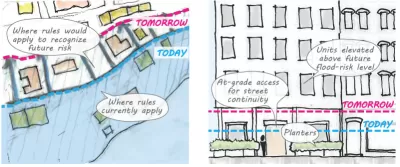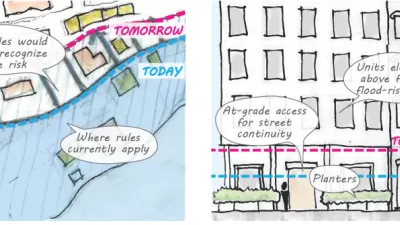Emergency responses to Hurricane Sandy have turned into long-term lessons in New York City, as the nation's largest city crafts a response to sea-level rise and extreme weather by making changes to the zoning code of coastal areas.

"The City Planning Commission (CPC) approved citywide zoning rules to protect coastal areas from flooding and sea level rise in a committee vote Wednesday," reports Chava Gourarie.
The new Zoning for Coastal Flood Resiliency (ZCFR) rules, detailed in an October 2020 Planetizen post, "would affect homes and buildings in areas designated as floodplains to ensure that they can withstand storms and other disasters, as well as recover from them quicker," explains Gourarie.
More specifically, according to Gourarie:
The proposed plan would allow existing homeowners and property owners to add resiliency measures, such as moving equipment to higher ground or elevating their structures. The new rules would allow more flexible zoning on new construction, introduce recovery measures that would be triggered by emergencies, expand the area eligible for the new zoning regulations, and restrict the number of new nursing homes built in flood zones.
If approved by the New York City Council, the zoning changes would permanently enshrine zoning changes implemented as an emergency measure after Hurricane Sandy.
More new coverage, by Mark Hallum, is available from AM New York. A press release from the New York City Department of City Planning includes soundbites on the approval from New York City Planning Commission Chair Marissa Lago.
FULL STORY: City Planning Commission Approves Citywide Coastal Zoning Rules

Alabama: Trump Terminates Settlements for Black Communities Harmed By Raw Sewage
Trump deemed the landmark civil rights agreement “illegal DEI and environmental justice policy.”

Planetizen Federal Action Tracker
A weekly monitor of how Trump’s orders and actions are impacting planners and planning in America.

Why Should We Subsidize Public Transportation?
Many public transit agencies face financial stress due to rising costs, declining fare revenue, and declining subsidies. Transit advocates must provide a strong business case for increasing public transit funding.

Understanding Road Diets
An explainer from Momentum highlights the advantages of reducing vehicle lanes in favor of more bike, transit, and pedestrian infrastructure.

New California Law Regulates Warehouse Pollution
A new law tightens building and emissions regulations for large distribution warehouses to mitigate air pollution and traffic in surrounding communities.

Phoenix Announces Opening Date for Light Rail Extension
The South Central extension will connect South Phoenix to downtown and other major hubs starting on June 7.
Urban Design for Planners 1: Software Tools
This six-course series explores essential urban design concepts using open source software and equips planners with the tools they need to participate fully in the urban design process.
Planning for Universal Design
Learn the tools for implementing Universal Design in planning regulations.
Caltrans
Smith Gee Studio
Institute for Housing and Urban Development Studies (IHS)
City of Grandview
Harvard GSD Executive Education
Toledo-Lucas County Plan Commissions
Salt Lake City
NYU Wagner Graduate School of Public Service





























